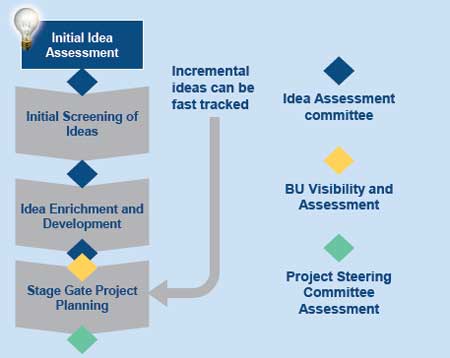BT & DTS EXECUTIVE UPDATE VOL. 22, NO. 8

We are entering an era that will demand unheralded levels of creativity because companies will need to constantly innovate and reinvent themselves to succeed in their search for growth and margins. The portion of revenues from breakthrough innovation1 is expected to grow four times faster than that from incremental innovation, according to a recent Arthur D. Little (ADL) survey of large organizations worldwide. Consequently, there will be increasing pressure on companies to generate a steady stream of high-quality ideas to deliver top- and bottom-line growth. (For further details on the survey, see Appendix.)
As we explore in this Executive Update, some leading companies are rising to the occasion by launching time-limited ideation challenges for key strategic issues and then instituting a dedicated process to enrich and select winning ideas. To support this initiative, senior leaders must devote a significant amount of time to ideation and be fully involved from start to finish in the ideation process. Lastly, innovation leaders must prevent excessive “infant mortality” of radical ideas and ringfence resources to maintain a balanced R&D portfolio.
Why Is Managing Ideas So Important?
This situation probably sounds familiar — your company brainstorms or applies other methodologies to generate a vast quantity of ideas; however, this process doesn’t seem to translate into a healthy, balanced portfolio of R&D projects. Certainly, there is an inherent ”creativity” among your people and a strategy is in place, but somehow the “killer ideas” just don’t seem to emerge. Getting this stage right is important for several reasons:
- Costs will incrementally rise. Ideas are initially free, but as time passes the sunk cost grows and grows. Getting the early stages right is important; otherwise, you waste money on failed or misaligned developments.
- Ideation is difficult. There is a reason we call ideation the “fuzzy front end”; it is much more nebulous than the downstream development processes. Risk is harder to manage because uncertainty is at its highest and outcomes are unpredictable.
- Putting the groundwork in place to exploit ideas requires drive, ambition, and vision. These goal-setting characteristics help mobilize the significant cross-functional and cross-divisional support required for success.
Ideation Challenges
Innovation ranges from new, radical business models (e.g., Uber) to low-technology marketing changes (e.g., Absolut honey-flavored vodka). The focus of this Update is about the process for creating and managing ideas that require significant R&D before commercialization within technology-intensive industries. Let’s examine four main challenges within ideation and idea management.
Formulating Ideas in Alignment with Strategy
Companies need to generate good original ideas in line with their strategy. In general, there are three main sources of inspiration for ideas:
- Customer requests for incremental improvements to existing products. The desire to please existing customers is noble, but these requests typically translate into very limited growth and will sometimes only maintain existing market shares in existing markets. In the modern world, don’t aim to stand still.
- Technology developments. R&D personnel typically unearth these developments, and they can be an important source of new growth. They often result from reserved technology “tinkering” time or partnerships with universities and can be important in demonstrating technical leadership.
- Ideas guided directly by strategy are typically acknowledged as the most valuable, destined to make the most significant contribution. These tend to come from insight into future market needs and are often based on relevant megatrends.
It is important to strike the right balance between these three sources of inspiration. The last category offers the most value in the long run but is also the most challenging.
Managing Quality vs. Quantity
Many tools are available that can help generate a vast quantity of ideas. The real challenge is emerging from this process with sufficient good business opportunities — well-crafted and well-articulated — that align with the company strategy and are ready to enter the R&D development portfolio. Open innovation approaches, in particular, can suffer from the “quality vs. quantity” challenge as innovation portals often end up drowning under a vast quantity of submitted ideas framed around the perspective of the submitter rather than the strategic needs of the company. Assessment of these ideas and managing the resulting intellectual property minefield can often tie up significant resources.
Coping with the Fragility of Ideas
Ideas are fragile. Infant mortality (of the ideas) is to be expected, of course, and is even desirable since the pipeline should be loaded with an excess of ideas to promote competition. However, it is important that good ideas survive and escape an early death if their potential was not easily apparent due to the use of inappropriate assessment criteria.
Finding Breakthrough Ideas
Breakthrough innovation is difficult. Indeed, ADL’s survey shows that 88% of responding companies are dissatisfied with their breakthrough innovation performance. To maintain a balanced R&D development portfolio, it is important to have a source of new breakthrough opportunities that can integrate well into the portfolio. We often see idea portfolios that are far too heavily weighted toward incremental innovation. Creating breakthrough ideas requires looking further afield and tends to be more challenging. Although 80% of surveyed companies believe it is important or very important to look externally for ideas, only 39% are satisfied with their performance at this.
Case Studies
From the rich material that surveyed companies shared, we have identified some common challenges regarding ideation. Anonymized case studies are presented below.
Case Study 1: Grand Ideation Challenges
Company A is in the oil & gas industry sector and has a turnover well in excess of about US $50 billion. To gather ideas to tackle key targeted strategic and operational issues, it launched the following time-limited external challenges:
- Back-office support. Tight deadlines have required Company A to develop a very robust “backroom” process and the capability to handle hundreds of submitted ideas in a short time frame. Every potential idea is subject to an assessment that results in rejection or enrichment of the initial idea.
- Customized assessment criteria. This process uses different assessment criteria for each business challenge. The review panels are composed of a fixed number of generalists who run the idea management process along with some specialists for each challenge.
- Online portal. There is a dedicated open innovation portal, where challenges are illustrated and the system tracks a number of key performance indicators on a dashboard for idea management: number of ideas, the review stage, evaluation and feedback, and so on. Company A has integrated LinkedIn with its innovation portal to make it possible to share ideas and insight discussions with a wider audience.
- Building insight. As well as a source of ideas in alignment with the strategy, one particularly novel outcome of the challenge approach has been the use of multiple internal and external contributions to generate broader and more general insights on challenge topics. Company A has captured and used these insights to structure feedback provided to idea generators as part of the idea-enrichment process.
Case Study 2: Idea-Enrichment Process
Company B is in the chemicals industry with a revenue of around $10 billion. As Figure 1 illustrates, this company employs a multistage process for ideation that focuses on identifying the correct challenges to pursue and then connecting with ideators (including using “grand” challenges, explained in the next section) to seek potential opportunities. The main focus is high value-add for modest effort.
The later stages of this process are designed to enrich and select ideas. This is performed using a small
four- to five-person idea committee, which is cross-functional and encompasses multiple business units to enable cross-fertilization. Subject matter experts are sometimes asked to add comments and integrate ideas. Business units get visibility of ideas before the stage gate project-planning stage and appoint a project leader and steering committee. The steering committee is responsible for approving that the project is ready to begin by validating the project plan, resources, and deliverables. Finally, lower uncertainty incremental ideas can be fast-tracked through the process to speed the route to development.

Figure 1 — Multistage ideation process. (Source: Arthur D. Little.)
Insights into Best Practice
Typically, companies that face ideation challenges have developed a strategy and have the required resources in place. However, the problem is often with the processes and, sometimes, the organizational structure. The following four best practices can help address these challenges:
- Launch “grand” challenges. Launch time-limited ideation challenges that align with company strategy. Each challenge should run for a limited duration (typically a few months) and be advertised to a range of internal and external sources of new ideas. This might involve a Web portal and announcements at research seminars, conferences, and other meetings to raise awareness. To get a valuable response, it is essential not only to ask the right questions but also to ensure that you frame and word them correctly. The approach described in Case Study 1 catalyzes idea generation in one area and helps ensure that the submitted ideas align with strategy. However, it requires a significant cross-functional backroom effort to assess challenges, consider synergies, enrich ideas, and provide feedback to idea creators. Internal contributors should be asked to comment on submitted ideas as well as on the topic in general. A key benefit of this approach is gathering and aggregating insight from a diverse range of sources to build a holistic understanding of the issue.
- Allocate resources for idea enrichment. Many tools for idea generation have been developed over the years and most include a selection stage. However, only relying on generating sufficient raw ideas and then hunting down the proverbial needle in a haystack is an inefficient approach. In contrast, top innovators should view the post-creation management of ideas as a distinct enrichment process in which complementary ideas can be combined or rejected ideas can shed light on those taken forward. Case Study 2 shows the implementation of a multistage process to gradually review, enrich, and select ideas — with each selection gate opening the door to increasing resources for investigation:
- The first review uses qualitative, business-driven criteria and leads to a commitment of minimal resources for investigation into major showstoppers. This will typically involve a few person-hours of effort per project as the key at this stage is to generate far more potentially high-value options than there are resources to develop.
- The second review uses a broader, cross-functional decision-making committee armed with better information, which potentially permits a more detailed exploration, typically with structured contributions from a multidisciplinary team to enrich and widen the solution space.
- By the final stage, surviving projects can be plotted on portfolio diagrams to give a holistic view of all projects ready for prioritization. Project proposals are prepared, and the first pivotal “go/reject/hold” decisions are made. Projects are selected to balance the portfolio of activities and will be allocated significant resources as they move into the implementation stage.
In all of this, it is important to find an efficient solution because the workload can easily spiral out of control if good organization, reporting, and assessment mechanisms are not developed.
- Engage senior leadership. As in so many aspects of innovation, senior engagement and support are key. Creating and enriching good ideas is one of the most challenging activities a company has to perform. Uncertainty and risk are high and often confidence is low, making it too easy to kill good ideas that could blossom. By way of example, one benchmark arranged monthly slots in a diary for ideation to secure VP attention. Another ensured senior business unit champions for every selected idea chartered for development. This provides visibility into the business units’ R&D activity and a steadying hand on the tiller.
- Use a different process for breakthrough ideas. You need to manage breakthrough ideas differently from incremental innovation. Breakthrough ideation requires the suspension of disbelief to prevent the rejection of imperfect ideas because they are not fully developed. In ADL’s survey, 60% of participants recognized modifying the ideation process as important or very important, but 75% had either not or only partially implemented the following:
- Modified selection criteria to manage increased risk and uncertainty and reduced knowledge
- Increased stages of enrichment (including chartered knowledge or competence building projects if required)
- Creation of separate organizational groups, if appropriate
- Development of a “radical” mindset; that is, flexible and open to opportunity without imposing unnecessary constraints
Conclusion
Many companies are unsatisfied with their innovation efforts and part of this is undoubtedly due to challenges around ideation and idea management. The required contribution of breakthrough innovation is ever-increasing, adding to this pressure. However, it is clear that some companies have developed strong processes and are reaping the rewards. The best practices outlined in this Update can help.
Ask yourself:
- Do you know your key strategic challenges? What is stopping you from launching a 100-day targeted challenge?
- How well do you enrich ideas? Do you just pick and choose, or do you learn from the losers as well?
- Does your senior leadership team have regular slots in the diary for ideation to support and engage in the ideation process? If not, why not?
- Do you have separate processes for radical ideas?
The good news is that there are a clear set of processes and best practices that your company can implement to greatly enhance the management of ideation. These practices generally don’t require extensive organizational change. What you do need, of course, is the will to change.
Appendix
In 2013, Arthur D. Little completed its 8th “Global Innovation Excellence Survey” (GIES), a cross-industry survey of trends and best practices in innovation management. Drawing on more than 1,000 responses across the past two GIES surveys, we have shed new, quantitative light on the basic key question: what innovation management techniques achieve the best return on innovation investment?
In 2014-2015, ADL followed up with a study to gain more in-depth qualitative insight into emerging R&D management practices, developing 23 case studies with 15 companies identified as innovation leaders. These global participants have an average revenue of about $30 billion and are spread across a broad range of technology-intensive industries (including medical devices, pharma, consumer goods, specialty chemicals, food and beverage, oil and gas, and industrial equipment). The firms are evenly split between those headquartered in the US and Europe.
In 2019, ADL integrated these best practices into the “Global Innovation Excellence Benchmark,” which now specifically includes assessments of ecosystem management, Agile, breakthrough innovation, and digitally driven innovation.
1 For more on breakthrough innovation, see “The Breakthrough Incubator: A Radical Model for Innovative New Business” and watch the Cutter Consortium webinar “How to Innovate Innovation: Creating New Stepout Businesses.”




